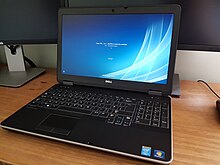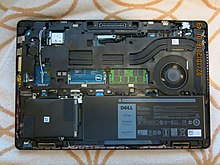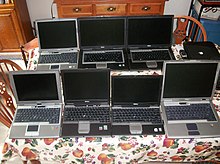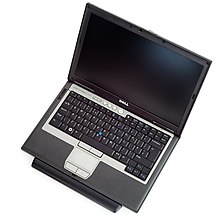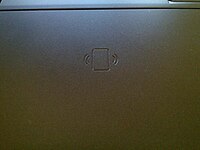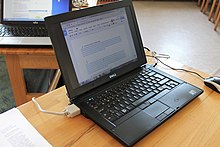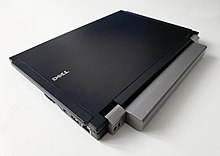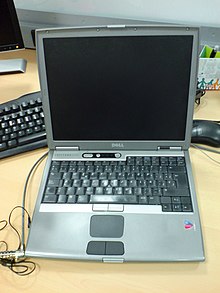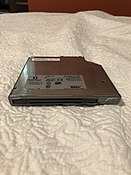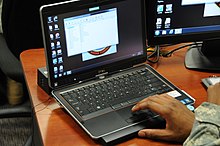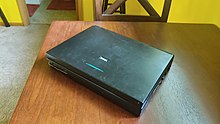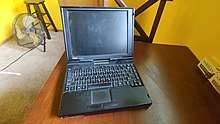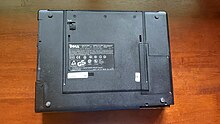Dell Latitude
The Latitude line directly competes with Lenovo's ThinkPad, HP's EliteBook, and Acer's TravelMate.
It aims to combine heavy-duty power with reasonable portability, and differs primarily from D8x0 series in screen size.
Unlike later D6x0 series machines, both memory sockets were accessible from a single cover on the bottom of the system.
The Latitude D600 used a PA-10/PA-12 charger and came with a DVD drive, 2 x USB, 1 x TV, 1 x network, 1 x parallel, 1 x serial, and 1 monitor output.
The hard drive is accessible through a cover on the left-hand front side of the lower case and is secured by 1 screw.
The D610 (released in 2005) was an update of the D600 design; it used a slightly modified D600 chassis, an extra 2 USB ports, and a newer Pentium M chipset ("Sonoma" with 533 MT/s FSB).
Unlike the D600 and prior midrange Latitudes (The 6xx series, dating back to the C-series) you had a choice of standard integrated Intel Graphics (GMA 900), or a discrete ATI solution (Radeon X300).
Some Dell Latitude D610 units with a dedicated ATI X300 graphics card seem to have problems with the audio-out jack.
Symptoms of this problem include a noise or whine when an audio device is connected to the audio-out jack.
The D620 marked the transition from strictly 32-bit processing to opening-up the potential to run 64-bit operating systems and applications.
It was initially sold with Intel integrated graphics, but an option to upgrade to a discrete Nvidia GPU became available after a few months.
The D630c was a slight variant model of the D630, featuring a "manageable" version of the motherboard chipset unavailable on the standard D630.
As a result, not much information about specific chipsets, graphics chip options (If there were any), or any other features can be found online for specifying details.
They are 2-spindle devices (removable optical drive interchangeable with D6xx/D8xx machines), and roughly follow the technical generations (chipset and processor-wise) of the D6x0 and D8x0 series.
It was essentially a D830 with, no TrackPoint, no smartcard reader, an option for a 14-inch screen (If this was chosen it would have a similar wider bezel as on the earlier D5xx series machines), and an AMD-based motherboard.
It does keep some premium features from the D830, such as a magnesium chassis, support for a 2nd battery, and a SATA based interface for the hard drive, allowing people to upgrade to a much faster SSD for cheap.
In order to make the laptops small and lightweight, some changes were made, such as ultra low voltage (ULV) CPU's, removal of the modular bay, no dedicated graphics, and in later models, 1.8-inch hard drives instead of the industry standard 2.5 inch.
Also, since they use ULV (ultra-low-voltage) processors and chipsets, and are generally less powerful, the technology does not correspond as closely as it does between other models in each generation — for example, the D420/D430 uses parallel ATA hard drives (1.8") rather than the SATA (2.5") interface in the D520/620/820.
It introduced a new design, newer ULV Dothan Pentium M's, and a Trusted Platform Module (TPM).
In a 22 °C ambient the D430 U7700 processor has been measured to run from 62 °C at idle to 85 °C under heavy system loads, that is, within 10 °C of Intel's max.
A Class Action Lawsuit settlement by NVidia was reached where certain Dell models were provided with replacement motherboards at no expense.
Dell posted notices to many of their laptop customers on August 14, 2006, saying that the Sony batteries on the D410, D500, D505, D510, D520, D600/D610, D620, and D800/D810 models were prone to bursting into flames, or even exploding.
The series was one of the first to offer the UXGA 1600×1200 resolution display, paired with a NVidia GeForce MX400 32 MB video accelerator.
The ATG as well as the XFR have a protective glass glued on top of the screen that often has glue leaking onto the display causing air bubbles to form.
[43] Dell has partnered with N-trig, providers of DuoSense technology, combining pen, capacitive touch and multi-touch in a single device.
A large number of user reports suggest that the Dell Latitude XT suffers from a major problem.
The improvements made with the N-Trig digitizer was mainly performance, not fixing its prevalent USB port or driver issues.
The chassis is a combination of a magnesium alloy that protected the corners and plastics covering the palmrest and bottom.
16 GB (on-board memory) Intel Dual Band Wireless AC 9462 Wi-Fi (802.11ac) 1x1 + Bluetooth 5.0 1920×1080
[139] For XPi and earlier models, the BIOS limited storage to an 8.4 gb or smaller hard drive.
